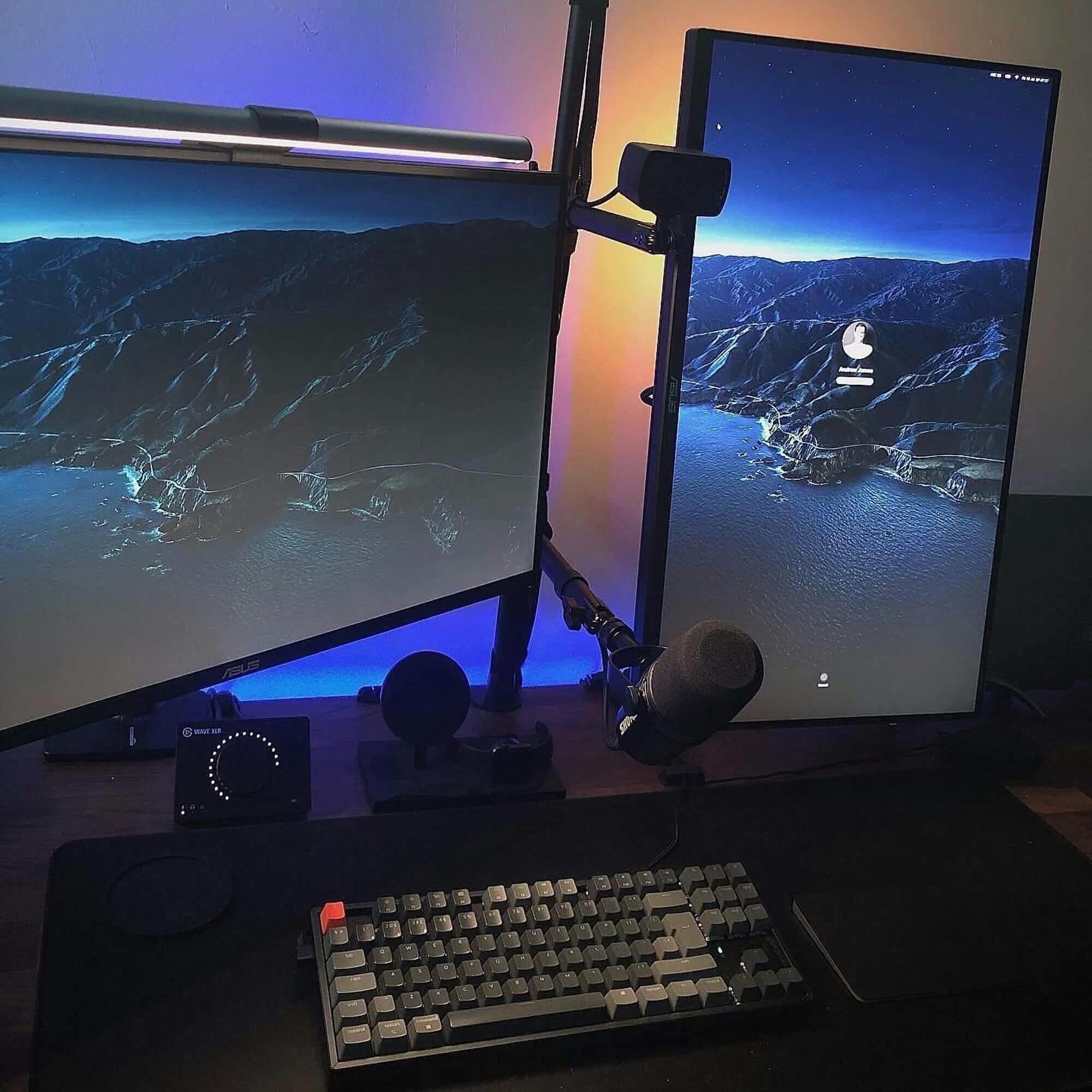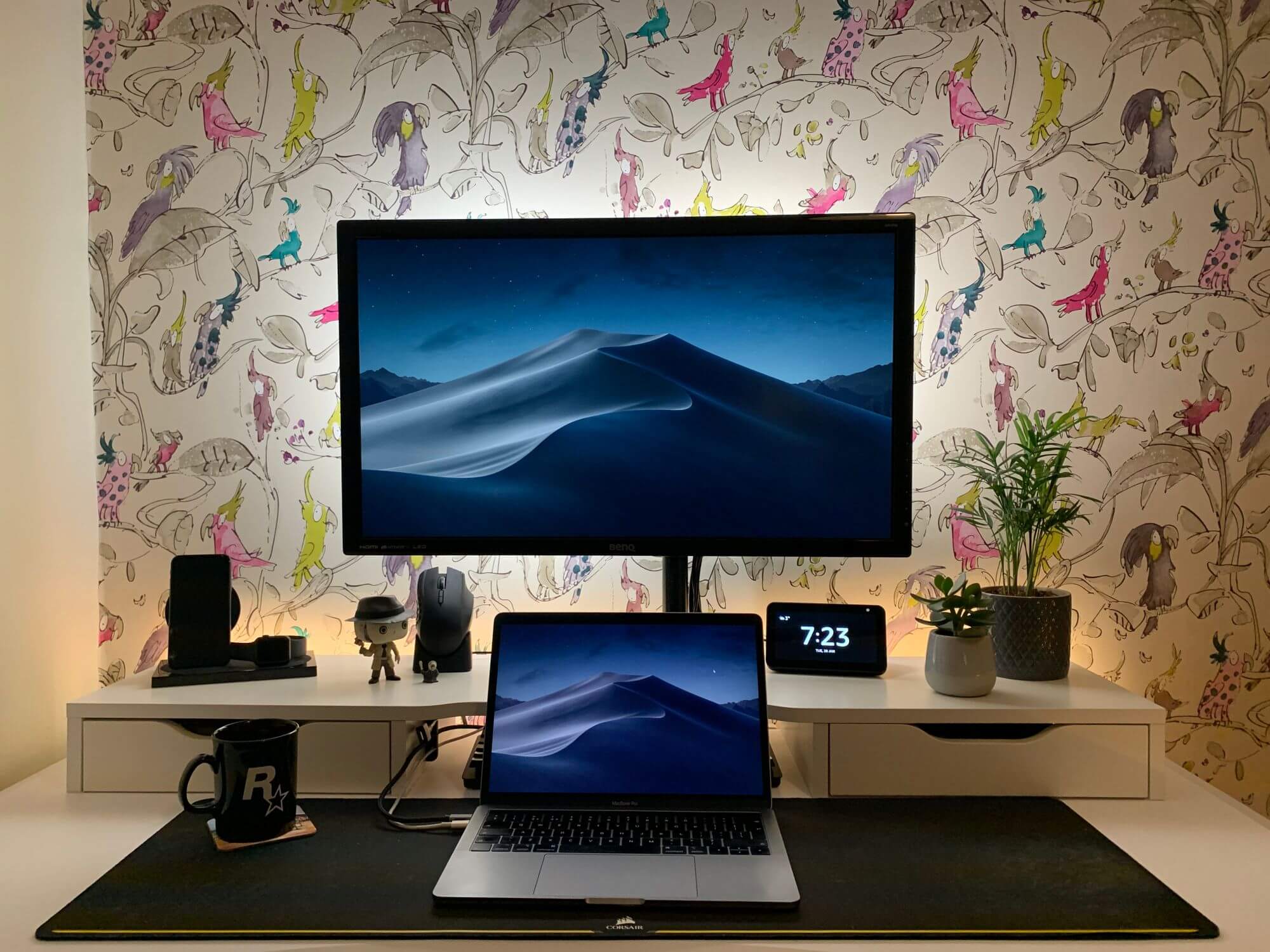
Back in 2020, I put together a list of basic principles for working from home. Where that focused on the ethos of working remotely, this time I’d like to discuss equipment that will allow you to be effective working in a remote environment.
Unfortunately, it’s impossible to recommend a setup that covers every use case. Everyone’s budget, available space, and personal circumstances are infinitely variable. This post will therefore assume you are working from a laptop, in a dedicated space, and are willing to spend a reasonable sum of money on upgrading your workstation.
For those interested in my personal setup, I’ve also included recommendations below each section that I’ve either used in the past, or I’m currently using at the time of writing.
Desk
It’s tough to recommend a desk, as it all comes down to available space and personal preference. My overarching advice is to minimise the clutter on the desk to optimise your working space. There should be enough space to type on your keyboard and scribble notes on a pad without rearranging the desk. Bigger is usually better.
Motorised standing desks are popular, but they can be expensive. If you don’t see yourself standing on a daily basis, spend the money elsewhere. I know plenty of people with height-adjustable desks that are permanently seated.
Try to position the desk close to any natural light. Facing the window is usually best. It can be visually stimulating, and it’ll give you the best lighting for conference calls. If you find yourself squinting or getting annoyed by the glare, rotate it perpendicular to the window. Try not to have your back to the window. This can lead to underexposure, making you appear as a silhouette on video calls.
Recommendation
Chair
On average, you’ll spend at least a third of the day sitting down, so it makes sense to invest in a high-quality ergonomic chair. My advice is to scan second-hand outlets (Facebook Marketplace, Gumtree, eBay, etc) for a Herman Millar chair. If space is limited, check out the Setu. I’m my opinion, the best all-rounder is the Mirra / Mirra 2. If money is no object, treat yourself to an Aeron!
When sat at your desk, you ideally want to be looking directly ahead or slightly below your eye level. Your elbows, knees, and hips should be at around 90 degrees, and your feet should be flat on the floor and in front of your knees.
Recommendation
Communication
Virtual meetings come with the territory. It’s important to ensure you are broadcasting clearly - both audibly and visually - and can focus on what is being said without becoming distracted.
Laptop speakers traditionally have poor fidelity, making it easy to miss something important. Nearby distractions can also cause you to lose focus. To counter both of these issues, I highly recommend noise-cancelling headphones. Although most conferencing software can detect audio feedback, headphones prevent your speakers from leaking unwanted noise into your microphone.
I also recommend using a dedicated webcam over the laptop’s integrated equivalent. The camera should be at least 1080p resolution, with a 30fps refresh rate, and a microphone if your headphones do not have their own. If you’re paranoid like me, it’s also worth looking out for a camera that comes with a physical privacy screen / slide for when it is not in use.
Recommendation
Monitor
One extra screen is essential. Two is optimal. My general recommendation for each screen is 1080p resolution, 60Hz refresh rate, and a 24” IPS panel. Ideally look for screens with little to no bezels (the plastic frame around the screen), especially if you are positioning them side by side.
Speaking of which, you definitely want to mount your monitors. Not only will it allow you to reposition the monitor to prevent neck strain, but it also frees up space on the desk and improves the overall aesthetic. I’ve been using the Amazon basic mounts for years and I love them!
Enjoying the article?
Support the contentRecommendation
Peripherals
Laptop keyboards are traditionally smaller than their external counterparts, which can feel cramped over longer periods of time. With the exception of a Macbook, trackpads are also notorious to work with. Even if you are working from a laptop, I’d still recommend using a wireless keyboard and mouse. Mechanical keyboards feel great to type on, and I’ve always preferred using a wireless mouse for both professional and personal use.
Rather than relying on Wi-Fi, it’s a good idea to use a powerline adaptor to connect your machine to your internet router. Depending on the condition of the wiring in your house, this usually leads to faster speeds and a more stable connection. Be sure to buy an adaptor that is capable of transferring the same speed as your service provides! It’s also worth investing in an adaptor that has a passthrough socket. This will prevent you from losing the socket when the adaptor is plugged in.
For those that split their time between the office and working from home, a USB hub is a great investment. It will allow you to connect all of your devices, internet, displays, and even charging to a single source. When it comes to working from home, all you need to do is plug a single cable into your laptop and you’re good to go!
Recommendation
Ambience
As trivial as it sounds, investing in appropriate lighting is a worthwhile investment. Diffusing the glare from the monitor with ambient light will reduce the strain on your eyes over long periods of time. This is especially important in rooms with low natural light. It also helps to personalise the space beyond the usual white walls.
I use a BenQ screen light that is mounted above my primary monitor. The back of my desk is fitted with a Philips Hue light strip, and my keyboard is backlit to make the keys easier to see in low-light conditions.
Recommendation
Miscellaneous
Plants are great for clearing the air and giving some visual stimulation. If you decide on a plant, I’d recommend something low maintenance - particularly those that survive well in low-light conditions and can go for extend periods if you forget to water it. The only thing worse than no plant is a dead one!
Everything gets dusty and dirty over time. Screen cleaner is great for removing fingerprints and streaks off of your monitor, and the microfibre cloth can also be used for dusting the desk off after the weekend.
Instead of a small mouse mat, I prefer one that spans the majority of my working space. It allows for wider sweeping motions with the mouse (this is handy when you have multiple monitors), it gives the keyboard extra grip to prevent slipping, and it helps prevent damage to the desk through continual use.
Repetitive strain injury is common for those of us typing on keyboards for extend periods of time. Adding a padded rest below the keyboard can help alleviate the strain on the wrists, and allow you to type for extended periods of time without any noticeable discomfort.
Finally, cable tidies are great for removing clutter from your desk. They can really give your desk a clean, minimal feel for a trivial cost.
Recommendation
Related Articles

- Productivity